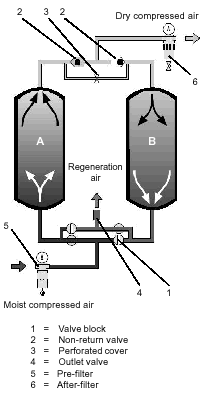<BR> Fig. 5.12: Op. diagram of an adsorption dryer,
cold regeneration
Fig. 5.12: Op. diagram of an adsorption dryer,
cold regeneration | Features
- Economical on smaller systems with low volume flows.
- Simple dryer construction.
- Can be used at high ambient temperatures.
- Low volume of drying agent.
Drying and regeneration times approx. 5 min.
- High operating costs.
The regeneration air is taken from the pneumatic system and can not be used further .
- Regeneration without outside energy.
- The percentage ratio of regeneration air to the output of the compressor falls with a higher final compression pressure.
These values are physically fixed and it is not possible to go below them. They are taken from the correlation between air moisture and compressed air pressure relief.
- Prefiltration of intake air.
A prefilter removes most of the oil, water droplets and particles of dirt.
- Postfiltration of dried compressed air.
Drying material taken with the compressed air from the drying tank must be filtered out.
|